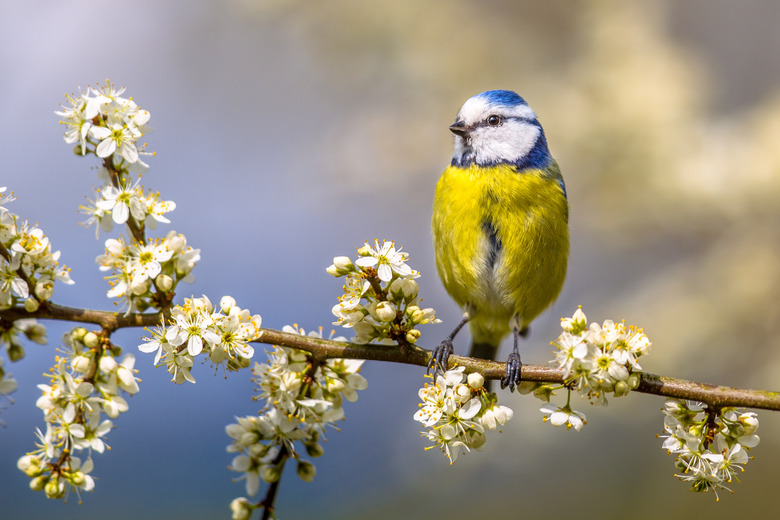Types Of Hawthorn Trees
Part of the rose family (Rosaceae), deciduous hawthorn trees (Crataegus spp.) have white spring flowers and attractive, round, edible fall fruits. Of the approximately 280 different kinds of hawthorn, most are shrubs. Tree-sized hawthorns generally grow to 25 feet tall. Native to the temperate areas of North America, Europe, and Asia, most hawthorn trees are well-armed with spines, but some thornless cultivars are available. Hawthorns are best used as accents, screens, barriers or hedges.
Thornless Trees
Thornless Trees
One of the drawbacks to using hawthorns are their spines, which make pruning and maintenance difficult. Cockspur hawthorn (Crataegus crus-galli) has abundant thorns as long as 3 inches that can inflict serious injury. Crusader is a thornless cultivar (Crataegus crus-galli 'Cruzam') that grows into a tree 25 to 35 feet tall and as wide. It's a perennial in U.S. Department of Agriculture plant hardiness zones 3 through 7. The hybrid Lavalle hawthorn (Crataegus x lavalleii) has lustrous green leaves, large orange-red fruits, and bronze-red fall foliage. Although it sports thorns, they are fewer in number than cockspur hawthorn. It's a medium-sized tree, 20 to 30 feet tall and 15 to 20 feet wide, suitable as a street or specimen tree. Lavalle hawthorn is a perennial in USDA zones 4 through 7.
Colorful Fruits
Colorful Fruits
Most hawthorn trees have red fruits, but some species have black or spotted fruits. Give variety to fall color by choosing a tree with a different color fruit. Black hawthorn (Crataegus douglasii) grows in western North America as a perennial in USDA hardiness zones 3 through 9. The 30-foot-tall tree bears black fruits that are sweet and juicy, suitable for eating fresh or for pies and preserves. A mostly thornless cultivar of an eastern North American hawthorn, Ohio Pioneer (Crataegus punctata 'Ohio Pioneer) has red berries prominently speckled with white dots. Ohio Pioneer is a perennial in USDA zones 4 through 7 and can grow to 30 feet tall.
Interesting Leaves and Bark
Interesting Leaves and Bark
Most hawthorns look similar. Consider varieties that have distinguishing features such as colorful bark or leaves. Washington hawthorn (Crataegus phaenopyrum), although it has green summer leaves, starts out with reddish-purple new leaves in spring and has purple, red and orange fall leaves. The white-flowered tree grows to 25 to 35 feet tall as a perennial in USDA zones 4 through 8. The silvery bark of Winter King Southern hawthorn (Crataegus viridis 'Winter King') peels to reveal orange under-layers, making it a handsome tree even in winter when it is bare of leaves. The large, bright orange fruits, small thorns, and disease resistance add to the tree's value. Winter King is a perennial in USDA zones 4 through 8.
Exotic Species
Exotic Species
Nonnative hawthorns from Europe or Asia make useful landscaping subjects. Chinese hawthorn (Crataegus pinnatifida) has long been grown for its berries. The thorns are short and not plentiful, and the plant grows 15 to 20 feet tall and 10 to 12 feet wide as a perennial in USDA zones 5 through 9. English hawthorn (Crataegus rhipidophylla, formerly C. laevigata) is suited for urban use, withstanding conditions such as drought, air pollution, and poor soil and drainage. The species is usually white-flowered, but colorfully flowered varieties include the red-flowered Crimson Cloud, double-flowered pale rose Masekii and pink-flowered Rosea. English hawthorn and its cultivars are perennials in USDA zones 4 through 7.
References
- Missouri Botanical Garden: Crataegus Crus-Galli "Cruzam" Crusader
- University of Florida IFAS Extension: Crataegus x Lavallei, Lavalle Hawthorn
- Plants For a Future: Crataegus Douglasii — Lindl.
- Missouri Botanical Garden: Crataegus Punctata "Ohio Pioneer"
- Plants For a Future: Crataegus Pinnatifida — Bunge
- University of Florida IFAS Extension: Crataegus Phaenopyrum: Washington Hawthorn
- University of Florida IFAS Extension: Crataegus Viridis "Winter King": "Winter King" Southern Hawthorn
